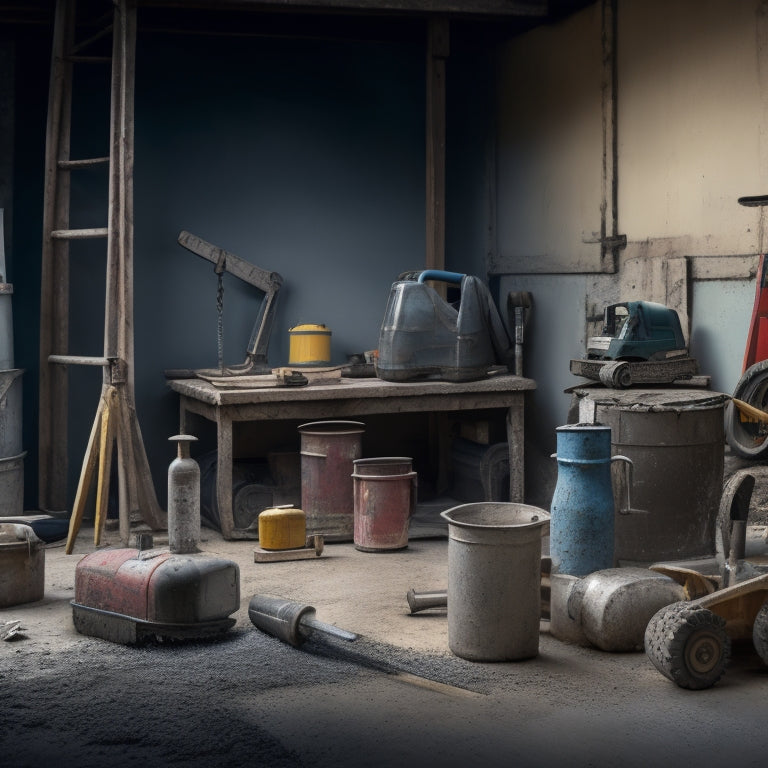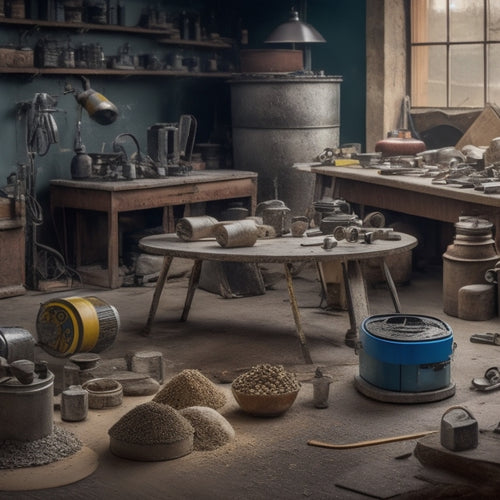
Concrete Repair Tools and Equipment Checklist
Share
You'll need a solid checklist of concrete repair tools and equipment to guarantee a successful project. Start with sealing and inspection essentials like pressure washers, wire brushes, and moisture meters. Then, gather sealing materials and supplies, including epoxy injection materials, and application equipment like sprayers and roller covers. Don't forget specialized block repair tools, such as block saws and pointing trowels, as well as safety equipment like hard hats and respirators. Finally, invest in measuring and testing devices like concrete moisture meters and pressure test kits. With these tools, you'll be well-prepared to tackle even the most complex repairs, and you'll uncover additional insights to ensure a job well done.
Key Takeaways
• A reliable cinder block sealer and pressure washer are essential for moisture control and surface cleaning before sealing.
• Choose the right type of sealant based on project specifications, including epoxy, polyurethane, and silicone-based sealants.
• Select application equipment, such as sprayers, roller covers, and extension poles, tailored to specific sealant requirements.
• Specialized block repair tools, including block saws, hammer drills, and pointing trowels, are necessary for cutting, removing, and applying adhesives.
• Don't forget personal protective equipment, such as hard hats, safety glasses, and respirators, to ensure safety on the job site.
Cinder Block Sealing Essentials
You'll need a reliable cinder block sealer and a few specialized tools to effectively seal your cinder blocks and prevent future damage. This is essential for block moisture control, as unsealed cinder blocks can absorb water, leading to cracking, spalling, and structural issues.
For cinder block maintenance, you'll require a pressure washer to clean the surface, removing dirt and debris that may interfere with the sealer's adhesion. A wire brush or scrubber will also come in handy to remove any efflorescence or mineral deposits.
Additionally, a roller or sprayer is necessary for applying the sealer evenly and efficiently. Don't forget to wear protective gear, including gloves, safety glasses, and a mask, to avoid exposure to harsh chemicals.
With these essentials, you'll be well-equipped to seal your cinder blocks and prevent water infiltration, ensuring the integrity and longevity of your concrete structure. By prioritizing block moisture control and cinder block maintenance, you can avoid costly repairs down the line.
Inspection Checklist for Block Walls
Your block wall inspection should start with a thorough visual examination of the surface, looking for signs of cracking, spalling, or efflorescence that could indicate underlying structural issues or water damage.
As you inspect, take note of any cracks, their length, width, and direction. Check for signs of movement, such as steps or stair-step cracks, which can indicate a more serious issue.
Next, perform a moisture assessment to identify any areas where water may be seeping into the wall. Check for signs of efflorescence, white salt deposits, or rust stains, which can indicate moisture issues. Use a moisture meter to measure the moisture levels in the wall.
In addition to visual inspection, you should also perform a tactile examination, feeling for any soft or hollow spots that may indicate damage or decay.
This detailed inspection is essential for effective block wall maintenance, as it allows you to identify and address any issues before they become major problems. By being proactive, you can extend the life of your block wall and prevent costly repairs down the line.
Sealing Materials and Supplies
When it comes to sealing materials and supplies, you'll need to take into account the right epoxy injection materials for your concrete repair job.
You'll also need to choose the appropriate concrete sealant type, depending on the specific requirements of your project.
Additionally, you'll want to make sure you have the necessary application equipment to get the job done efficiently and effectively.
Epoxy Injection Materials
Epoxy injection materials, including sealing materials and supplies, play a critical role in concrete repair by providing a strong, durable bond between the concrete and the injected epoxy. As a concrete repair professional, you understand the importance of selecting the right epoxy formulation techniques for your specific structural repair applications.
When choosing epoxy injection materials, consider the following key factors:
| Epoxy Property | Description | Application |
|---|---|---|
| Viscosity | Measure of thickness and flowability | Thin epoxies for narrow cracks, thick epoxies for wide cracks |
| Pot Life | Time before epoxy hardens | Fast-setting epoxies for emergency repairs, slow-setting epoxies for large projects |
| Flexibility | Ability to absorb movement | Flexible epoxies for joints and cracks prone to movement |
| Chemical Resistance | Resistance to corrosion and chemicals | Epoxies resistant to acids, alkalis, or other corrosive substances |
| Bond Strength | Adhesion to concrete | High-strength epoxies for critical structural repairs |
Concrete Sealant Types
Selecting the right concrete sealant type from a range of sealing materials and supplies is crucial to achieving a successful concrete repair, as it helps prevent further damage and guarantees the longevity of the structure. You'll need to take into account factors such as sealant durability, compatibility with the substrate, and environmental conditions.
Common sealant types include acrylic, polyurethane, epoxy, and silicone-based sealants, each with its own strengths and weaknesses. When choosing a sealant, you should evaluate the level of protection required, as well as the surface preparation and application techniques involved.
For instance, epoxy-based sealants offer excellent chemical resistance and are ideal for high-traffic areas, while acrylic sealants are more suitable for exterior applications due to their UV resistance.
It's also important to take into account the viscosity and flow characteristics of the sealant, as this can affect its ability to penetrate the concrete and form a strong bond. By selecting the right sealant type and understanding its properties, you can guarantee a successful concrete repair that lasts for years to come.
Application Equipment Needed
You'll need a range of application equipment to effectively apply the chosen sealant, guaranteeing a uniform coat and strong bond with the concrete surface. This includes various sprayer types, such as handheld, backpack, and cart-mounted sprayers, each suited for specific sealant viscosities and application areas. Handheld sprayers are ideal for small, intricate areas, while backpack and cart-mounted sprayers are better suited for larger areas.
For roller applications, you'll need a range of roller covers, including microfiber, foam, and lambswool rollers. Microfiber rollers are best for applying thin, even coats, while foam rollers are better for thicker, textured finishes. Lambswool rollers are ideal for applying sealants to rough or porous surfaces.
Additionally, you may need extension poles, spray tips, and other accessories to facilitate efficient and effective application. Ascertain you choose the right equipment for your specific sealant and application requirements to achieve a professional-grade finish.
Specialized Block Repair Tools
When repairing damaged concrete blocks, having the right specialized tools can make all the difference in achieving a strong, long-lasting bond. You'll need equipment designed specifically for block repair techniques that can handle the unique demands of this type of work.
For instance, you'll require a block saw or a masonry saw to accurately cut and remove damaged blocks. A hammer drill or rotary hammer will come in handy for removing old mortar and preparing the surface for new blocks. Don't forget a pointing trowel for applying specialized adhesives and filling gaps between blocks. A level and a string line will guarantee your repairs are straight and level.
Additionally, you may need a mixing bucket and a mixing stick for preparing epoxy-based adhesives or other specialized bonding agents. A notched trowel or a finishing trowel can be used to apply and smooth out these adhesives.
With the right tools, you'll be able to execute block repair techniques with precision and confidence, resulting in a durable and long-lasting repair.
Safety Equipment for Masonry Work
Protecting yourself from the hazards associated with masonry work is essential, as the physical demands and potential risks of this trade can be significant.
You'll be working with heavy materials, power tools, and heights, which can lead to injuries or even fatalities if you're not properly equipped.
To guarantee your safety on the job site, you'll need the right masonry safety gear. Here are some essential items to include in your checklist:
-
Hard hats and safety helmets to protect your head from falling objects and debris
-
Safety glasses and goggles to shield your eyes from dust, chemicals, and other hazards
-
Steel-toed boots and non-slip footwear to prevent foot injuries and slips
- Fall protection equipment, such as harnesses and lanyards, to prevent falls from heights
Measuring and Testing Devices
Accurate measurements and tests are essential in masonry work, and having the right measuring and testing devices guarantees that your concrete repair projects meet the required standards.
You'll need devices that can accurately measure concrete moisture, as excess moisture can lead to structural issues. A concrete moisture meter is a must-have tool for this purpose. It helps you determine the moisture levels in the concrete, confirming you don't apply coatings or sealants too soon.
You'll also need to perform pressure testing to identify any weaknesses in the concrete. A pressure test kit allows you to simulate real-world loads on the concrete, helping you identify areas that require repair or reinforcement.
Additionally, you may need other devices such as a laser level, digital caliper, and thermometer to confirm accurate measurements and temperature control. These devices will help you detect any defects or irregularities in the concrete, enabling you to take corrective action and confirm a successful repair project.
Frequently Asked Questions
Can I Use Regular Cleaning Products to Prepare the Concrete Surface?
When it comes to surface preparation, you can't rely on regular cleaning products. They mightn't effectively remove dirt, grime, and oils that can compromise the bond between the old and new concrete.
Instead, you'll need specialized cleaning solutions designed for concrete surface preparation. These solutions will guarantee a clean, porous surface that's ready for repair.
Using the right products will save you time and assure a strong, long-lasting bond. Don't take shortcuts – choose the right cleaning solutions for the job.
How Do I Determine the Best Repair Method for My Concrete Issue?
You're at a crossroads, trying to 'separate the wheat from the chaff' to find the best repair method for your concrete issue.
To get started, you'll need to conduct a thorough surface assessment to identify the root cause of the problem. This will help you determine which repair techniques are most suitable.
Consider factors like crack width, depth, and location, as well as the type of concrete and its current condition.
What Is the Ideal Temperature for Applying Concrete Sealers?
When applying concrete sealers, you'll want to take into account the ideal temperature for best results. Generally, you should aim for temperatures between 50°F and 90°F (10°C and 32°C).
Avoid applying sealers in direct sunlight, high winds, or extreme weather conditions. Timing is essential; wait for a calm, overcast day with minimal humidity.
This guarantees the sealer adheres properly, providing a durable, long-lasting finish. By choosing the right application timing and weather conditions, you'll get the most out of your concrete sealer.
Can I Rent Specialized Block Repair Tools Instead of Buying Them?
You're probably thinking, 'I don't want to break the bank on specialized tools for a one-time block repair job.'
And you're right, buying them mightn't be the most cost-effective option.
Fortunately, you can rent block repair tools instead of purchasing them.
Many equipment rental companies offer a range of specialized tools for block repair, including grinders, saws, and mixers.
This way, you can get the job done without the hefty upfront investment.
Are Masonry Workers Required to Wear Steel-Toed Boots on the Job Site?
You're on the job site, and you're wondering about safety regulations. Specifically, you're asking if masonry workers need to wear steel-toed boots.
The answer is yes. OSHA requires protective footwear in hazardous environments, and construction sites fall under that category.
Steel-toed boots are a must to prevent foot injuries from heavy objects or tools. It's crucial to follow footwear requirements to guarantee your safety and the safety of others around you.
Conclusion
With your concrete repair toolkit complete, you're now fully fortified for flawless fixes.
From fortifying fragile facades to filling fissures with finesse, you've got the fundamental fixtures and specialized solutions to salvage structural sanctity.
Safeguard your site with scrutiny, selecting the suitable supplies for a sturdy, stress-free repair process.
Related Posts
-

Essential Tools for Concrete Wall Covering Projects
When tackling a concrete wall covering project, you'll need a range of essential tools and equipment. For cleaning an...
-

Top DIY Concrete Grinding and Polishing Tools
When selecting DIY concrete grinding and polishing tools, you'll want to take into account a range of factors to guar...
-

Essential Power Tools for DIY Concrete Sculpting
As you begin DIY concrete sculpting, you'll need a strategic selection of power tools to achieve professional-grade r...


